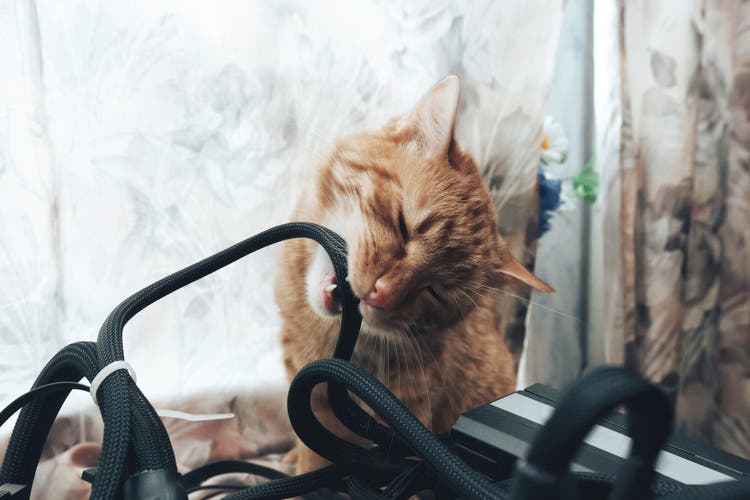
Common Household Dangers for Cats
Similar to bringing any pet home, you have to make sure that you’ve gone ahead and pet-proofed your home to ensure that your new feline friend won’t encounter any dangers that could put potentially put their life at risk.
Cats are curious animals and they like to investigate their surroundings, sometimes even getting into mischief while doing so. The mischief is what you’re hoping to avoid, especially if it can put your cat’s life in danger. As a cat owner, you have to come to expect that your cat can and will always find new ways to get into trouble. The more you can educate yourself on potential hazards in your home, the better you’ll be able to protect your cat(s).
Some of the most common household dangers for cats are the ones that you wouldn’t generally think of. These may be items that you may have lying around the house, things you thought were supposed to be good for cats, or things that you just didn’t know were dangerous! Below is a list of common household dangers for cats.
Top Household Dangers
String/Yarn
A common stereotype, yet total misconception when it comes to cats is how yarn is a good toy. Yarn, or string in general — an item that seems harmless in nature — can, in fact, be very dangerous for cats. If swallowed, string can cause life-threatening intestinal issues for cats. If you decide to give your cat a ball of yarn to play with, make sure that you supervise them the entire time. Never leave them unattended.
Exposed Electrical Wires
Similar to string or yard in terms of cats’ interest are exposed electrical wires, which for obvious reasons can also be extremely dangerous. Wires are tempting for cats to chew on, but they can easily electrocute and even kill your cat. Ensure that all exposed wires are hidden away and out of reach from your cat.
Plants
Do you have plants around the house? Well, it might be time to either move them or get rid of them as you bring your cat home. Many common houseplants such as lilies, sago palm, and azalea, among others can be harmful to cats. Lilies, for example, are extremely toxic to cats and can result in life-threatening kidney failure.
Rubber Bands
As much as some cats love playing with these, just like string or yarn, they’re very dangerous if swallowed, so keep these out of reach!
Plastic Bags
While seemingly harmless to us, cats can easily suffocate themselves with plastic bags. Be sure to keep any extra ones that you keep around the house in a cabinet or bin and away from your furry friend!
Garden Products/Household Cleaning Supplies
This goes for all chemicals in general. As with any chemical, there is a considerable risk associated with exposure, let alone consumption. A couple of examples of household items that fall into this category include fertilizer, mulch, antifreeze, paint thinner, drain cleaners, chlorine, heavy-duty dish soap, and so on. Be absolutely sure that these are tucked away in a cabinet and cannot be accessed by your cat.
Washing and Drying Machines
Unlike humans, cats love to crawl into small spaces and hide. This includes your washing and drying machines. If you’ve got a pet cat, verify that they’re not playing hide and seek in your washing or drying machines prior to doing a load of laundry.
Milk
Surely you’ve seen milk given to cats in movies and TV shows, but milk being good for cats is actually a big myth because most cats are lactose intolerant and can encounter side effects that include vomiting, diarrhea, and an upset stomach.
Window Screens
Cats spend much of their lazy time looking out of windows and if your screen is poorly constructed, weak, or even loose, they can easily fall out of the window, which leads to injury or even death if you’re high up off the ground.
Mini Blinds
These are more dangerous for kittens than cats, but either way, climbing blinds should be discouraged as it’s possible for a kitten to hang itself on the cord of the blinds. A quick spray of water from a spray bottle will discourage your cat from climbing the blinds.
Preventing Your Cat From Getting into Danger
While the best thing you can do to prevent your cat from getting into danger is to eliminate potentially dangerous items around the house, you can also train it to exhibit positive behavior so as to avoid the danger altogether. Although cats don’t necessarily listen to commands as well as dogs do, they’re still capable of learning and listening.
The best way to train a cat is by using a clicker. This gives them a distinct noise that they can learn to recognize. You should make the noise before feeding them. They will begin to associate the noise with something positive, such as receiving food. Your cat will eventually learn to come to you when they hear the noise because they expect to receive food.
This practice should begin from short distances, with rewards given every time your cat comes to you. Eventually, your cat will come to you every time they hear the click.
An easy way to discourage bad behavior, such as climbing on the blinds, eating plants, or getting into the washing machine is to gently spritz your cat with water when they’re exhibiting undesirable behavior. This is an unpleasant feeling for them and they will look to avoid it. Over time, they’ll realize that every time they climb the blinds, they get sprayed with water, so they’ll eventually stop climbing the blinds. This is the case for all other undesirable behavior as well.